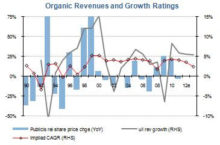Publicis Q1 – positive revenue momentum, but is this the real story?

The narrative the markets will focus on will remain the group’s ability to translate its digital and emerging market investments into premium revenue growth and further margin progress. From this perspective, Publicis’s Q1 revenue performance should be well received. A +6.5% rise in organic revenues pipped Omnicom’s +5.2%, reflecting continued progress in digital (+12.6% to 28.2% of revenues) and emerging markets (23.4% of revenues; +1.4pts YoY u/l), while the +58% rise in net new business (to $1.9bn) suggests the service proposition continues to resonate with clients to underpin further relative outperformance. Average net debt meanwhile is down by €500m YoY to only -€100m and the group is sitting on €3.9bn of liquidity, including €2.7bn of committed facilities and €1.7bn of cash and marketable securities.
Markets may focus on the top-line delivery, but the real story should be on what happens to this liquidity. Historically, agencies have applied cashflow to buy new marketing skills to extend their service proposition to clients. This is a great way to build your business and it can also be earnings beneficial as internal investment (thru the P&L) is displaced by acquisition expenditure on intangibles, that loiter in the balance sheet and are broadly ignored in earnings assessments. Markets are not dumb however and recognise that some, or all, of these acquired intangibles are being consumed and discount equity valuations accordingly.
Q1 Revenues
Organic revenue growth of +6.5% vs Q4’s +12.8% rate of growth slowed as expected from Q4 spectacular levels (+12.4%), albeit by slightly less than the tightening comparatives might have suggested (Q1 comps at +3.1% were 8pts less favourable than Q4’s -5.1%). By region, growth was again driven by
- North America: 49% of revenues and +8.1% u/l in Q1 vs +14% in Q4 with digital continuing to provide the key driver to growth.
- Europe: 32% of revenues and +6.2% u/l in Q1 vs +11.3% in Q4 with growth from N and C&E Europe (France +8.2%, Germany >+10%, Russia & CEE +7%, UK +2.4%, but S. Europe trailing)
- LatAm: 5% of revenues and +8.7% in Q1 vs +22.1% in Q4. Declines across Mexico and Columbia partially offset continued strong growth from Brazil and Argentina (>+20%) and Venezuela (>+15%)).
- Asia: 12% of revenues with Q1 at +1.5% vs +6.4% u/l in Q4 as declines across Japan, Australia and Korea substantially absorbed the +8.2% increase from Greater China.
- A&ME: 2% of revenues and -0.5% u/l in Q1 vs +15.3% in Q4. With political unrest sweeping across the Middle East, revenues have unsurprisingly stalled, albeit with some regions still posting growth (UAE +7% u/l).
- BRIC: +11.4%
Valuation – Q1 Revenues
As with other agencies I would expect Publicis’s valuation range will continue to be defined by its revenue outlook, which for the moment remains positive. Historically, Publicis has tended to trade at a small discount (on a growth rating basis) to larger agencies, such as WPP and Omnicom, although its current revenue and net business performance may challenge this. At current levels I estimate the shares are discounting trend growth at around 3.5-4.0% pa for 2011 and 2012, possibly dropping to approx +2.5% by 2013. This values the equity at nearer the lower end of what I would regard as a comfortable trading range of +3.5-4.5% and with scope to see this edge up the nearer +5% should the group demonstrate restraint on blowing its balance sheet on an aggressive acquisition spree.



Has anyone noticed that many agencies are currently priced at little more than they have invested in acquisitions over the past decade? For an industry model based on applying cashflow into acquisitions rather than returning to shareholders, this might seem a little embarrassing. When most agencies are also delivering sub-GDP organic revenue growth, despite heavy investments into ‘new’ growth areas, this might pose a challenge to the whole growth model on which agencies have been based. For Publicis, I estimate that over €9bn has been spent on acquisitions since 1999 (net of disposals and at constant 2010 prices), which is only 13% less the current EV of the group.


